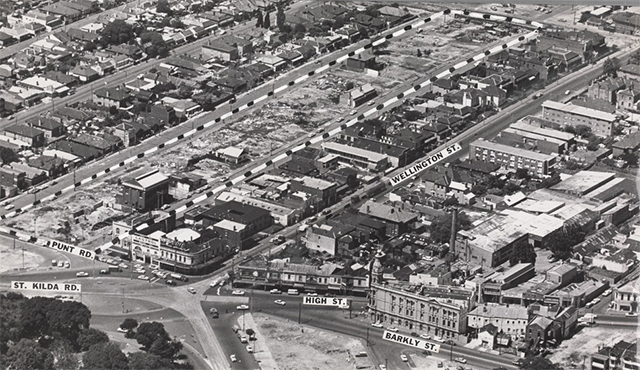A cursory survey of newspaper articles suggests that the Junction was a dangerous place with many accidents and fatalities reported.1 Traffic management issues continued to be associated with the Junction into the 1950s as road traffic, trams and pedestrians continued to compete for use of the Junction. However, in 1950 the State Government indicated any major reshaping of St Kilda Junction was a long way off, the targeted shops and houses were considered too valuable at the time for demolition and the need to deal with the pressures of housing and urban slums was seen as a higher priority.2
This did not stop the agitation for change however, or deter multiple plans by various segments of the community for a reshaping and 'proved' Junction, such as the plan shown below proposed by the Town and Country Planning Association in 1950.3
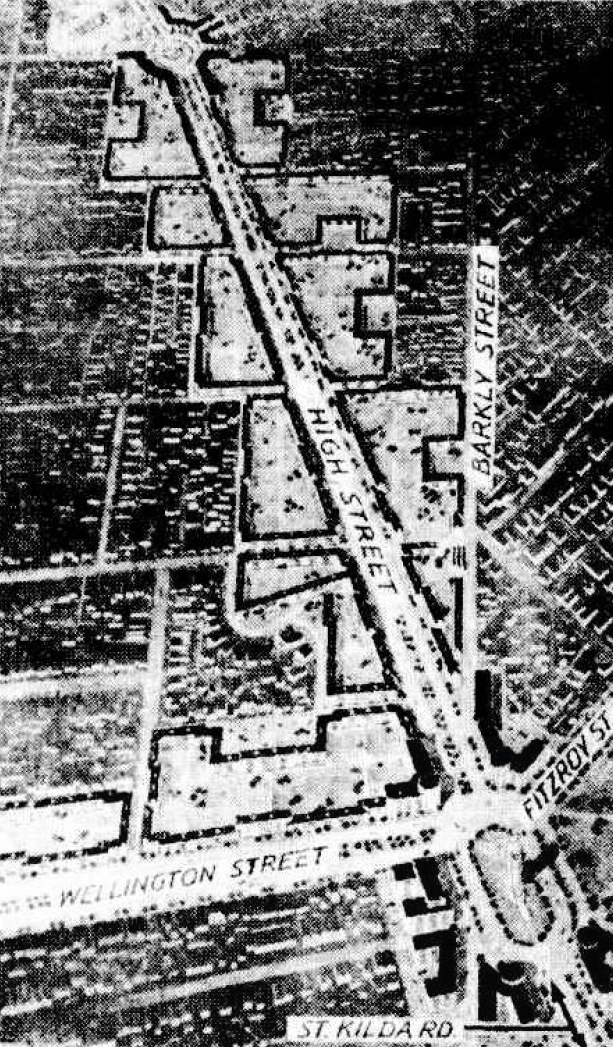
Developed by the Town and Country Planning Association and released in 1950
This plan shows projected rows of flats along High St and a proposed garden 'island' at the Junction
In 1953 a range of traffic alteration such as additional traffic lights and traffic diversion through specific streets tried to improve the traffic congestion however, this was only a stopgap measure.4 The following year the 1954 Melbourne Metropolitan Planning Scheme Report identified St Kilda Junction as needing an upgrade due to the growth of Melbourne’s population and the associated traffic. It noted that road communication to the southern suburbs made it impossible to avoid the Junction and that peak hour traffic would become very heavy. The report suggested a roundabout as an immediate solution to be followed more substantive road works when warranted.5
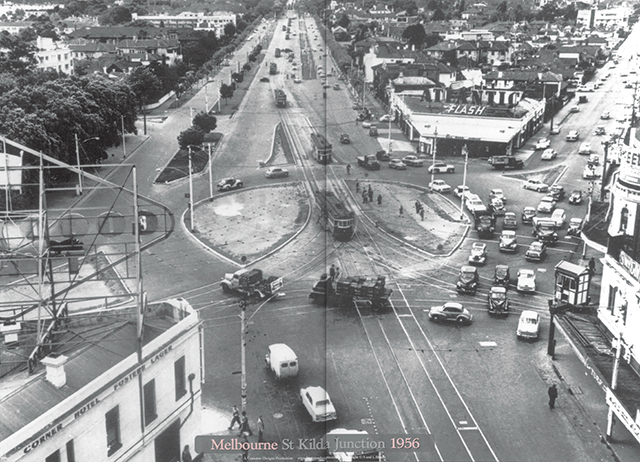
Traffic using the St Kilda Junction roundabout ca 1956
The report’s proposed changes to the Junction helps illustrate how changes in population size and mobility, combined with rising commuter expectations for reduced travel times have influenced urban design and planning. The proposed changes also reveal how the needs and amenity of one section of society can have precedence over the needs and amenity of a different section. For example, the needs of commuters to outer suburbs compared the needs of local St Kilda residents and pedestrians.
During the mid-1950s the St Kilda City Council and the State Government were locked in bureaucratic wrangling over the Junction and whether to ‘roundabout’ or ‘not roundabout’ and who was going to pay for it. Anne Longmire reports that the Country Roads Board experimented by installing a temporary roundabout at the Junction in April 1955. It seems it was an immediate success and Longmire notes that the Herald on the 19 April reported, ‘on the day of it's opening, peak traffic flowed through much more quickly and there was only one accident when two cars driven by New Australians collided’. It seems this was not to last as Longmire went on to state ‘that the roundabout was soon damaged, with the timber marking the traffic lanes splintered and flattened, and the sandbags burst but neither the State Government nor the St. Kilda City Council would finance its repair’.6
St Kilda City Council removed the roundabout in February 1956 after arguments with the Government over financing.7 Some motorists observed the old roundabout route and others tried to take a more direct route resulting in chaos.8 The Argus newspaper responded to the removal of the roundabout on the 22 February stating ‘Jungle Law Is Back’ and went on to say that ‘jungle law returned to St Kilda Junction in the peak hour last night. And is expected to be worse today’.9 Premier Bolte directed the Country Roads Board to restore the roundabout on 23 February 1956. However, the Premier stated it was to be temporary until a more permanent structure was in place.10 Anne Longmire reports the structure was soon labelled a paddling pool because it was undrained. The roundabout was described as ‘a filthy pile of split sandbags, smashed bottles, rocks and scraps of tin and wire’ by October 1956 and it was in such a disgraceful condition the St. Kilda Boy Scouts volunteered to clean it prior to the Olympic Games.11 The pressure was on for some more permanent solution to the Junction’s traffic problems.
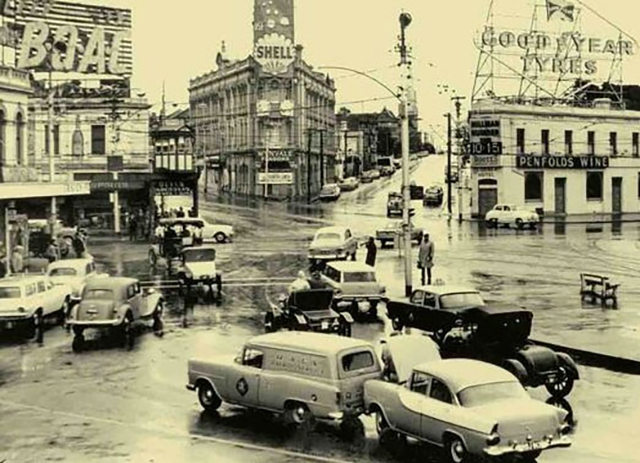
Traffic accident and traffic jostling through the roundabout at St Kilda Junction 1962
Another feature of the Junction through the Twentieth-century was as a location for advertising billboards. Traffic congestion and commercial advertising have had a long association with the Junction. (Picture from Scott Brodie, Coniston Designs)
The 1950s and 1960s saw the increased mobility of the population and traffic volume through greater access to private vehicles, a general move from inner city living to outer suburban areas and increasing distances between home, work and other amenities such as shops, schools and hospitals , etc. Such changes increased traffic volume and put increasing pressure on intersections like St Kilda Junction. For example, Graeme Davison reported that in 1951 scarcely one Melbournian in ten had journeyed to work by car. By 1964 nearly one-third (31%) were driving or riding in a car. In 1974 the proportion had more than doubled again to almost two-thirds (66%).12 During the same period there was a decline in the use of public transport. Graeme Turnbull reports that ‘patronage of tram and tramway bus dropped from 263 million in 1949/50 to 209 million ten years later. By 1965/66 it had fallen to 166 million and by 1969/70 patronage had declined to 133 million'.13
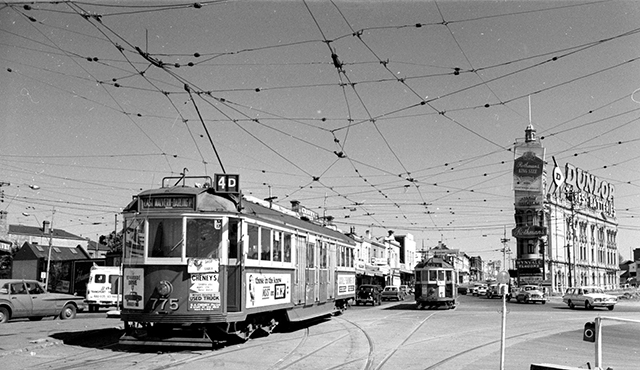
View of the junction just before commencement of the redevelopment 1967
The decline of public transport use and the increase in car use must have been on the minds of the planners contemplating changes to St Kilda Junction. In the late 1960s the Victorian Government announced plans for a major redevelopment of St Kilda Junction. This huge project managed by the Melbourne Metropolitan Board of Works (MMBW) was completed in stages and included expanding Queens Road to four lanes, a six lane extension was formed passing under St Kilda Road and linked to Dandenong Road, the tram line running up Wellington Street was diverted up into the underpass and Queens Road. Over one hundred and fifty houses, forty-two shops, fifty-two business as well as other premises were demolished.
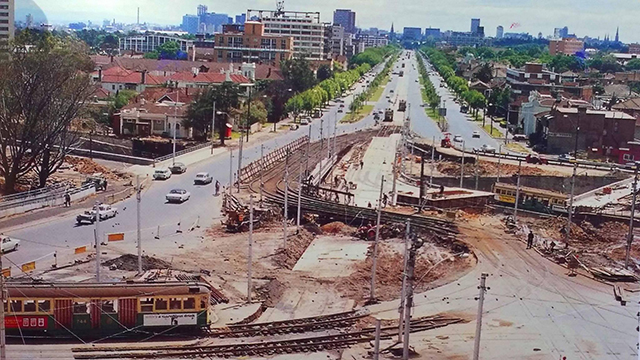
Redevelopment of St Kilda Junction ca 1967-69
The initial St Kilda Junction redevelopment included the retention of the East Brighton and Malvern Burke Rd trams in narrow Wellington Street but the Melbourne Metropolitan Tramways Board successfully lobbied for the trams to utilise the central median strip of the extended Queens Way. When it opened on 11 December 1968 it represented a symbolic relocation and reaffirmation of Melbourne’s tramway system.14
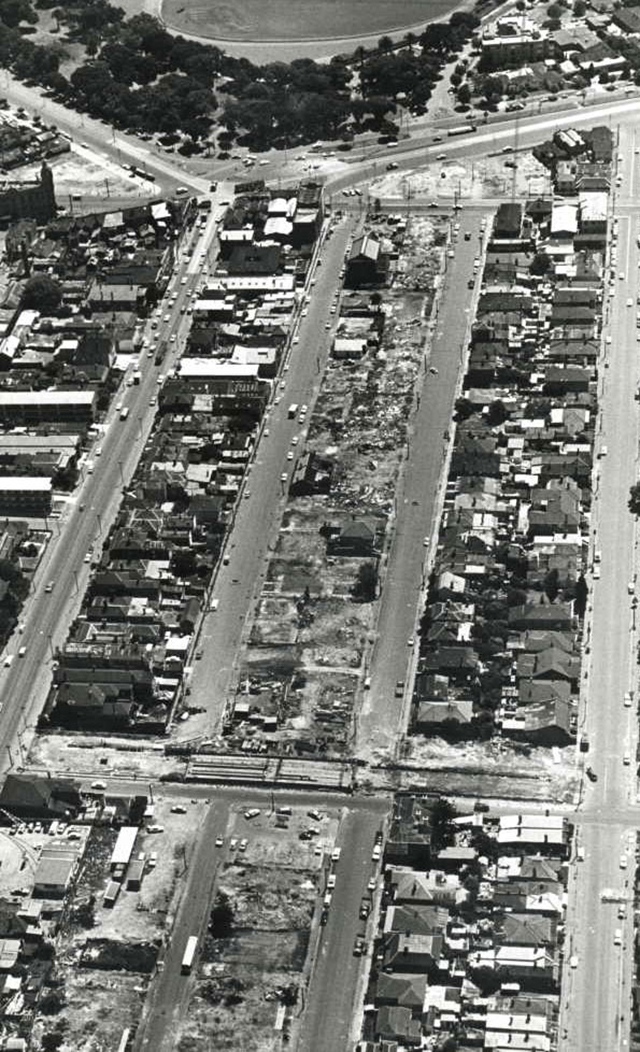
Demolitions to make way for the four-lane extension of Queens Way at St Kilda Junction ca 1967
Annie Longmire recalls the staunchest resistance to the demolitions came from Nellie Collins of Vine Street, Windsor, a sixty-six year old woman who had lived the street for forty years. She was initially offered $6,000 and $600 disturbance money by the MMBW, but stubbornly refused to accept it. Her home was demolished by front-end loader in March 1967 when she was out, and the Land Valuation Board in 1968 eventually awarded her $9,640, which was less than the MMBW's final offer. However, Longmire also states that the MMBW did take special care to save the Corroboree Tree when it realigned twenty metres of St. Kilda Road so that none of the main tree roots were touched.15 It seems the MMBW could be clandestine with individuals like Nellie Collins but sympathetic to community concerns regarding the Corroboree Tree. One threatened the viability of the project and so required harsh direct action, while the other could be settled by compromise and gave the MMBW an opportunity for some positive publicity to offset the negative aspects of displacing so many residents and businesses.
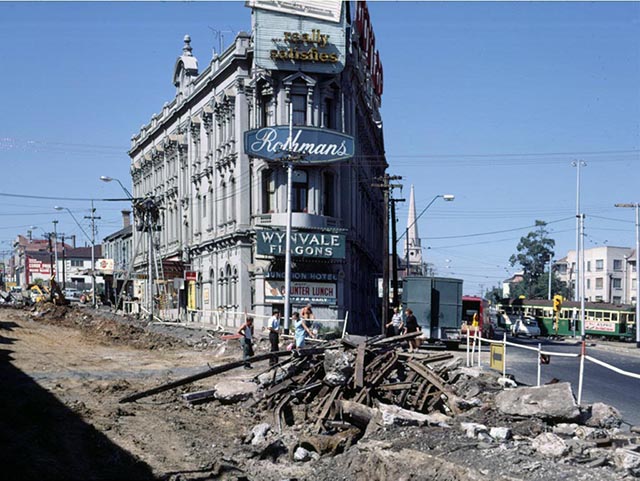
The Road at the Junction being torn up as part of its redevelopment.
The Junction Hotel is in the background just before its demolition ca 1972
(Picture from Trams Down Under Archive)
In 1970 plans were announced for the long proposed widening of High Street to make it an extension of St Kilda Road. In 1973 demolition of over one hundred and fifty by then dilapidated buildings and the impressive Junction Hotel were underway.16
The Junction would never be the same again.
Footnotes
- 'Driver and Two Passengers Injured', The Argus, Tuesday January 4, 1927, p. 15; 'Woman Fatally Injured', The West Australian, Monday February 13, 1928, p. 16; 'ROAD ACCIDENTS. MOTOR-CYCLIST KILLED. Skidded Into Back of Lorry', The Argus, Tuesday September 10, 1929, p. 9; 'TRAFFIC PROSECUTIONS. ST. KILDA JUNCTION ACCIDENT. Driver Fined'. The Argus, Thursday January 5, 1933, p. 11; 'Injured Boy Taken to Hospital', The Argus, Saturday June 16, 1934, p. 16; 'ACCIDENTS AT ST. KILDA Man Killed; Youth Injured', The Argus, Friday January 31, 1936, p. 10; 'MOTORS ACCIDENTS. Heavy Toll. ONE KILLED; MANY INJURED.?', The Sydney Morning Herald, Monday May 11, 1936, p. 10; 'SOLICITOR KILLED. In Motor Fatality. MELBOURNE, May 11', Townsville Daily Bulletin, Tuesday May 12, 1936, p. 6; 'FATAL ACCIDENT?', The Argus, Monday July 15, 1940, p. 2; 'TRAFFIC SNARLED BY FATAL SMASH', The Mercury, Wednesday September 9, 1953, p. 3.
- 'St. Kilda Junction Scheme Yeas Off', The Age, Friday January 27, 1950, p. 4.
- 'They plan to change St. Kilda', The Argus, Thursday January 26, 1950, p. 1.
- 'Traffic Diversion at St. Kilda', The Age, Thursday 7 May 1953 p.1.
- Melbourne and Metropolitan Board of Works, Melbourne Metropolitan Planning Scheme 1954 report, Melbourne, 1954 p.101.
- A. M. Longmire, The History of St Kilda: Volume 3 The Show Goes On: 1930 to July 1983, Hawthorn, 1989, p. 182.
- 'Traffic Triangle Back at Junction: Roundabout Goes After Squabble', The Age, Wednesday February 22, 1956, p. 3.
- 'St. Kilda Junction Confusion', The Age, Wednesday February 22, 1956, p. 1.
- 'Jungle law Is Back', The Argus, Wednesday February 22, 1956, p. 5.
- 'New roundabout will be temporary – Bolte', The Argus, Friday February 24, 1956, p. 6.
- A. M. Longmire, The History of St Kilda: Volume 3 The Show Goes On: 1930 to July 1983, Hawthorn, 1989, p. 183.
- G. Davison, with S. Yelland, Car Wars: How the car won our hearts and conquered our cities, Sydney, 2004, p. 26.
- G. Turnbull, The development and retention of Melbourne’s trams and the influence of Sir Robert Risson, RMIT working paper series, Melbourne, August 2002, p. 25.
- Biosis Research, Melbourne Metropolitan Tramways Heritage Study, Port Melbourne, 2011, p. 92.
- A. M. Longmire, The History of St Kilda: Volume 3 The Show Goes On: 1930 to July 1983, Hawthorn, 1989, p. 201.
- ibid., pp. 200-201.


